|
Pinocchio In Outer Space
(1964)
Director: Ray Goossens
There's a question that has been plaguing me about Pinocchio
for
years, ever since I first saw the movie as a child. That question is:
What
did Pinocchio die from during the climatic escape from Monstro the
whale?
I mean, look at it; it couldn't have been from drowning, because we had
seen him walking around unharmed on the bottom of the ocean floor
several
minutes earlier. It couldn't have been from the tail smash, because
Geppetto
survived that (and he was an old man!) As a kid, I used my 8mm Fisher
Price
hand 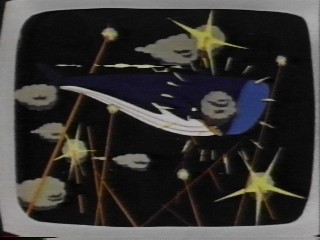 cranked movie
player to play that
sequence from the movie over and over,
for any sign of a clue (occasionally watching it backwards for humorous
effect - I loved the subsequent effect of seeing Geppetto lying on the
beach and getting swept away
to sea by the tide.) To this day, I still don't have any idea what made
Pinocchio
die. At least there is an explanation for Pinocchio's death in
Pinocchio
In Outer Space. In the climax of this family movie, Pinocchio
gets
roasted alive from a flaming jet coming out of a big spout, and we see
him die before our eyes. True, it is strange that his body and clothing
isn't blackened and burned in the least (probably the director was
afraid
of traumatizing children more than they should be), but it's at least
clear
why Pinocchio dies this time around. cranked movie
player to play that
sequence from the movie over and over,
for any sign of a clue (occasionally watching it backwards for humorous
effect - I loved the subsequent effect of seeing Geppetto lying on the
beach and getting swept away
to sea by the tide.) To this day, I still don't have any idea what made
Pinocchio
die. At least there is an explanation for Pinocchio's death in
Pinocchio
In Outer Space. In the climax of this family movie, Pinocchio
gets
roasted alive from a flaming jet coming out of a big spout, and we see
him die before our eyes. True, it is strange that his body and clothing
isn't blackened and burned in the least (probably the director was
afraid
of traumatizing children more than they should be), but it's at least
clear
why Pinocchio dies this time around.
If this sequence sounds a bit out of place for a kiddie
movie, wait until you see every scene in Pinocchio In Outer Space,
an utter bastardization of the classic Carlo Collodi tale. There are so
many ways in which this movie goes wrong, but the biggest mistake the
people
behind this movie made was to view the original classic tale as not
being
"hip" or "with it". This is the kind of thinking that's given us
t-shirts
with Bugs Bunny dressed in gangbanger clothing, or having the Muppets 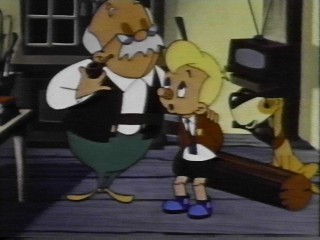 singing
"Brick House". Not only are such sights ridiculous to our eyes, but
they
show the people behind the characters having no confidence with the
original
material that has managed to entertain millions without any kind of
enhancement.
This sequel not only gets a massive update it, but it twists it around
so perversely that you can't take your eyes off the mess happening in
front
of you. At the end, you are exhausted, and can't immediately put into
words
about what you have just seen, except that Collodi must be spinning
around
in his grave. singing
"Brick House". Not only are such sights ridiculous to our eyes, but
they
show the people behind the characters having no confidence with the
original
material that has managed to entertain millions without any kind of
enhancement.
This sequel not only gets a massive update it, but it twists it around
so perversely that you can't take your eyes off the mess happening in
front
of you. At the end, you are exhausted, and can't immediately put into
words
about what you have just seen, except that Collodi must be spinning
around
in his grave.
This new adventure for Pinocchio takes place not that
long after his original adventures. So you think Pinocchio and Geppetto
lived happily ever after? Wrong, buster. Seems that after Pinocchio's
dream
of becoming a real boy became true, he soon went off the wagon and
started
to revert to his mischievous ways, including stealing cookies and
smashing
children's heads together with great force. So as a punishment, the
Blue
Fairy turned him back to being more wooden than Al Gore. Humbled,
Pinocchio
resolves to work at becoming good enough in the Blue Fairy's eyes so
that
he may be turned into a real boy once again.
Okay...that setup is not so bad. But as Geppetto says
shortly, "Strange times, Pinocchio - a whale in space!" Yes, you read
that
right. As Pinocchio gets ready to go to school, there's an announcement
on the workshop's TV. Yes, a TV. Maybe it wasn't that long ago in time
when the
original adventure happened after all. Anyway, the TV report is about
"Astro,
The Rogue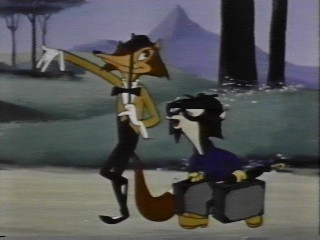 Whale From Outer Space!" Seems Astro came
out of nowhere, and
has put a serious crimp into the space program, because he keeps
smashing
up all the satellites up there. Pinocchio gets it in his head that this
must be the key to becoming a real boy - stopping Astro! Geppetto
condescendingly
tells Pinocchio, "You'll probably see interplanetary travel in your
lifetime!"
sending him off to school before starting work on carving a spaceship
out
of a log (for, you see, kids of these days would never be satisfied
with
a simple horse or something just as equally unexciting.) Whale From Outer Space!" Seems Astro came
out of nowhere, and
has put a serious crimp into the space program, because he keeps
smashing
up all the satellites up there. Pinocchio gets it in his head that this
must be the key to becoming a real boy - stopping Astro! Geppetto
condescendingly
tells Pinocchio, "You'll probably see interplanetary travel in your
lifetime!"
sending him off to school before starting work on carving a spaceship
out
of a log (for, you see, kids of these days would never be satisfied
with
a simple horse or something just as equally unexciting.)
Pinocchio leaves home for school, and starts singing one
of the three songs of the movie, It's A Goody Good Morning
(Lyrics excerpt: "It's a goody good morning / And a goody good day /
It's a happy
dappy dippy dappy lolla dappy doozy all the way"), and one can't help
but
notice that all the woodland animals hearing Pinocchio don't, for once,
dance around the singing hero, but instead run away from 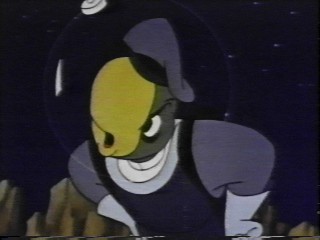 him. Soon Pinocchio
bumps into some old acquaintances of his - or are they? You remember
that
in the Disney version, the two dishonest fellows went by the names J.
Worthington
Foulfellow and Gideon. But here the fox is named "B. Sharp", and his
feline
sidekick not only is named "Mr. Groovy" ("L-l-l-l-l-ike groovy, man!"),
he's also a beatnik! Once again, they con our wooden friend, getting
him
to buy a hypnotism book so he can hypnotize Astro the whale. But how
will
Pinoc get up into space? Well, it so happens an alien named Nurtle
(voiced
by Arnold Stang) lands his spaceship a few minutes later, and after
explaining
to Pinocchio that he's a Twurtle and not a turtle, invites Pinocchio to
go out into space with him to explore Mars and look for Astro at the
same
time and - him. Soon Pinocchio
bumps into some old acquaintances of his - or are they? You remember
that
in the Disney version, the two dishonest fellows went by the names J.
Worthington
Foulfellow and Gideon. But here the fox is named "B. Sharp", and his
feline
sidekick not only is named "Mr. Groovy" ("L-l-l-l-l-ike groovy, man!"),
he's also a beatnik! Once again, they con our wooden friend, getting
him
to buy a hypnotism book so he can hypnotize Astro the whale. But how
will
Pinoc get up into space? Well, it so happens an alien named Nurtle
(voiced
by Arnold Stang) lands his spaceship a few minutes later, and after
explaining
to Pinocchio that he's a Twurtle and not a turtle, invites Pinocchio to
go out into space with him to explore Mars and look for Astro at the
same
time and -
(Note: I paused several minutes after writing all the
above in order to
regain my sanity, until realizing that what I had written was, in fact,
what happened in the movie.)
Pinocchio In Outer Space is a terrible
movie
in so many ways. The story isn't just awful in its updating, but in its
refusal to find a constant tone. Though it panders to the kiddies, at
the
same time the screenplay actually tries to educate the kiddies in an
incredibly
contrived manner. So out of the blue, Nurtle will spout out a
scientific
fact such as, "Mars is smaller t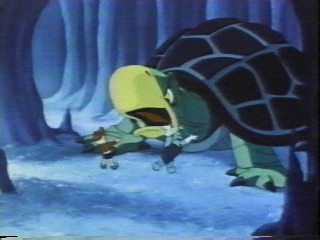 han Earth, so the horizon is shorter. And
there's far less gravity!" Many of these facts will go over the heads
of
kids, and even adults will eventually be fed up by how obsessively the
movie attempts to hit the audience over its head with education. But
what
is worse about the story is that between taking off from earth and
encountering
Astro the whale, there is an incredibly long jaunt on Mars that ends up
not affecting the Astro section in any possible way. All the Mars
section
seems to be for is to pad up the short running time of this feature
with
scientific facts and monstrous visuals of mutant sandcrabs and other
ghastly
creatures that will probably freak out the younger kiddies. han Earth, so the horizon is shorter. And
there's far less gravity!" Many of these facts will go over the heads
of
kids, and even adults will eventually be fed up by how obsessively the
movie attempts to hit the audience over its head with education. But
what
is worse about the story is that between taking off from earth and
encountering
Astro the whale, there is an incredibly long jaunt on Mars that ends up
not affecting the Astro section in any possible way. All the Mars
section
seems to be for is to pad up the short running time of this feature
with
scientific facts and monstrous visuals of mutant sandcrabs and other
ghastly
creatures that will probably freak out the younger kiddies.
The animation comes across as if it was done by an
unespecially
talented European member of Hanna-Barbera's TV animation unit of the
time.
The three songs the movie boast are the pits, with high-pitched notes
there
and elsewhere in the 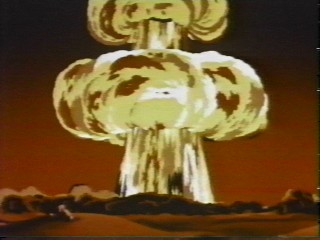 movie that will shatter the lenses in your
glasses.
The...well, everything is just plain bad in this movie, right down to
the
shoddy print and video transfer used for the actual video itself. This
movie does the impossible, by managing to totally bungle every possible
thing it tries to do. This is the kind of bad that even kids won't
forgive.
I'm afraid if I go on describing every failure, I'll just sound like a
whiner.
Really, this movie is just plain bad. No extra synonyms have to be
used,
just "bad" will describe the entire movie. Let's end it here and go
onto
the next movie. movie that will shatter the lenses in your
glasses.
The...well, everything is just plain bad in this movie, right down to
the
shoddy print and video transfer used for the actual video itself. This
movie does the impossible, by managing to totally bungle every possible
thing it tries to do. This is the kind of bad that even kids won't
forgive.
I'm afraid if I go on describing every failure, I'll just sound like a
whiner.
Really, this movie is just plain bad. No extra synonyms have to be
used,
just "bad" will describe the entire movie. Let's end it here and go
onto
the next movie.
UPDATE: Philippe Capart sent this along:
"I just stumbled on the review for the film
Pinocchio in Outer Space. It's very sharp!, I am a Belgian
animator/director and am actually doing a documentary on the Belgian
studio Belvision (The studio who worked on the film). The director of
the film Ray Goossens had just finished working on the Tintin
TV-Series (1959) (created from the base of a two pilots made by Larry
Harmon (at Hanna-Barbara?) when he started on Pinocchio
(1961-62).
"There were only two animators for this film! (and about 8-9
inbetweeners and cleaners) and Willy Lateste (the second animator) was
"formed" by Goossens. This was the first feature length film for this
studio. The film was designed for TV, Norman Prescott and Fred Ladd
(the Americans at the base of this film) tried to find a studio abroad
to make this "sequel", they tried Yugoslavia, didn't work out and they
found "Belvision" in Brussels. Belvision was a sister company of the Le
Lombard, the publisher of the once famous European "Tintin" magazine.
With little budget, they tried to take a piece of the TV-Market.
"Pinocchio started out as a TV-feature film
but the work was so great (sic) that they decided to make it a theatre
hit. After this film, Ray Goossens tried to work on The Flintstones
for Hanna and Barbara with his Belvision team (they knew Charles Shows,
a script writer who worked for Hanna and helped on the adaptation of
the Tintin series). They made a pilot episode (with French (Belgian)
accents!) but it didn't go further.
"I have seen the first version of the story-board done by an American
named Freund, it was great work and much funnier than the finished
version; something went wrong...
"Well, I thought maybe this would be of some interest to the person
having written the review (it might give you some information on why
it's so ...well not that great!)"
Check for availability on Amazon (VHS)
Check for availability on Amazon (DVD)
See also: Jimmy The Boy Wonder,
The Last Unicorn, Willy McBean
|

 cranked movie
player to play that
sequence from the movie over and over,
for any sign of a clue (occasionally watching it backwards for humorous
effect - I loved the subsequent effect of seeing Geppetto lying on the
beach and getting swept away
to sea by the tide.) To this day, I still don't have any idea what made
Pinocchio
die. At least there is an explanation for Pinocchio's death in
Pinocchio
In Outer Space. In the climax of this family movie, Pinocchio
gets
roasted alive from a flaming jet coming out of a big spout, and we see
him die before our eyes. True, it is strange that his body and clothing
isn't blackened and burned in the least (probably the director was
afraid
of traumatizing children more than they should be), but it's at least
clear
why Pinocchio dies this time around.
cranked movie
player to play that
sequence from the movie over and over,
for any sign of a clue (occasionally watching it backwards for humorous
effect - I loved the subsequent effect of seeing Geppetto lying on the
beach and getting swept away
to sea by the tide.) To this day, I still don't have any idea what made
Pinocchio
die. At least there is an explanation for Pinocchio's death in
Pinocchio
In Outer Space. In the climax of this family movie, Pinocchio
gets
roasted alive from a flaming jet coming out of a big spout, and we see
him die before our eyes. True, it is strange that his body and clothing
isn't blackened and burned in the least (probably the director was
afraid
of traumatizing children more than they should be), but it's at least
clear
why Pinocchio dies this time around.
 singing
"Brick House". Not only are such sights ridiculous to our eyes, but
they
show the people behind the characters having no confidence with the
original
material that has managed to entertain millions without any kind of
enhancement.
This sequel not only gets a massive update it, but it twists it around
so perversely that you can't take your eyes off the mess happening in
front
of you. At the end, you are exhausted, and can't immediately put into
words
about what you have just seen, except that Collodi must be spinning
around
in his grave.
singing
"Brick House". Not only are such sights ridiculous to our eyes, but
they
show the people behind the characters having no confidence with the
original
material that has managed to entertain millions without any kind of
enhancement.
This sequel not only gets a massive update it, but it twists it around
so perversely that you can't take your eyes off the mess happening in
front
of you. At the end, you are exhausted, and can't immediately put into
words
about what you have just seen, except that Collodi must be spinning
around
in his grave.
 Whale From Outer Space!" Seems Astro came
out of nowhere, and
has put a serious crimp into the space program, because he keeps
smashing
up all the satellites up there. Pinocchio gets it in his head that this
must be the key to becoming a real boy - stopping Astro! Geppetto
condescendingly
tells Pinocchio, "You'll probably see interplanetary travel in your
lifetime!"
sending him off to school before starting work on carving a spaceship
out
of a log (for, you see, kids of these days would never be satisfied
with
a simple horse or something just as equally unexciting.)
Whale From Outer Space!" Seems Astro came
out of nowhere, and
has put a serious crimp into the space program, because he keeps
smashing
up all the satellites up there. Pinocchio gets it in his head that this
must be the key to becoming a real boy - stopping Astro! Geppetto
condescendingly
tells Pinocchio, "You'll probably see interplanetary travel in your
lifetime!"
sending him off to school before starting work on carving a spaceship
out
of a log (for, you see, kids of these days would never be satisfied
with
a simple horse or something just as equally unexciting.)
 him. Soon Pinocchio
bumps into some old acquaintances of his - or are they? You remember
that
in the Disney version, the two dishonest fellows went by the names J.
Worthington
Foulfellow and Gideon. But here the fox is named "B. Sharp", and his
feline
sidekick not only is named "Mr. Groovy" ("L-l-l-l-l-ike groovy, man!"),
he's also a beatnik! Once again, they con our wooden friend, getting
him
to buy a hypnotism book so he can hypnotize Astro the whale. But how
will
Pinoc get up into space? Well, it so happens an alien named Nurtle
(voiced
by Arnold Stang) lands his spaceship a few minutes later, and after
explaining
to Pinocchio that he's a Twurtle and not a turtle, invites Pinocchio to
go out into space with him to explore Mars and look for Astro at the
same
time and -
him. Soon Pinocchio
bumps into some old acquaintances of his - or are they? You remember
that
in the Disney version, the two dishonest fellows went by the names J.
Worthington
Foulfellow and Gideon. But here the fox is named "B. Sharp", and his
feline
sidekick not only is named "Mr. Groovy" ("L-l-l-l-l-ike groovy, man!"),
he's also a beatnik! Once again, they con our wooden friend, getting
him
to buy a hypnotism book so he can hypnotize Astro the whale. But how
will
Pinoc get up into space? Well, it so happens an alien named Nurtle
(voiced
by Arnold Stang) lands his spaceship a few minutes later, and after
explaining
to Pinocchio that he's a Twurtle and not a turtle, invites Pinocchio to
go out into space with him to explore Mars and look for Astro at the
same
time and -
 han Earth, so the horizon is shorter. And
there's far less gravity!" Many of these facts will go over the heads
of
kids, and even adults will eventually be fed up by how obsessively the
movie attempts to hit the audience over its head with education. But
what
is worse about the story is that between taking off from earth and
encountering
Astro the whale, there is an incredibly long jaunt on Mars that ends up
not affecting the Astro section in any possible way. All the Mars
section
seems to be for is to pad up the short running time of this feature
with
scientific facts and monstrous visuals of mutant sandcrabs and other
ghastly
creatures that will probably freak out the younger kiddies.
han Earth, so the horizon is shorter. And
there's far less gravity!" Many of these facts will go over the heads
of
kids, and even adults will eventually be fed up by how obsessively the
movie attempts to hit the audience over its head with education. But
what
is worse about the story is that between taking off from earth and
encountering
Astro the whale, there is an incredibly long jaunt on Mars that ends up
not affecting the Astro section in any possible way. All the Mars
section
seems to be for is to pad up the short running time of this feature
with
scientific facts and monstrous visuals of mutant sandcrabs and other
ghastly
creatures that will probably freak out the younger kiddies.
 movie that will shatter the lenses in your
glasses.
The...well, everything is just plain bad in this movie, right down to
the
shoddy print and video transfer used for the actual video itself. This
movie does the impossible, by managing to totally bungle every possible
thing it tries to do. This is the kind of bad that even kids won't
forgive.
I'm afraid if I go on describing every failure, I'll just sound like a
whiner.
Really, this movie is just plain bad. No extra synonyms have to be
used,
just "bad" will describe the entire movie. Let's end it here and go
onto
the next movie.
movie that will shatter the lenses in your
glasses.
The...well, everything is just plain bad in this movie, right down to
the
shoddy print and video transfer used for the actual video itself. This
movie does the impossible, by managing to totally bungle every possible
thing it tries to do. This is the kind of bad that even kids won't
forgive.
I'm afraid if I go on describing every failure, I'll just sound like a
whiner.
Really, this movie is just plain bad. No extra synonyms have to be
used,
just "bad" will describe the entire movie. Let's end it here and go
onto
the next movie.